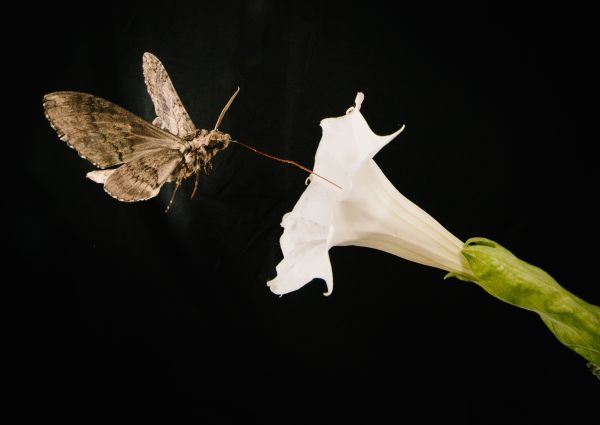According to a latest research, pollution and other odors causes hindrance for insects in search of flowers to feed on. In a joint study, researchers from the University of Arizona and University of Washington studied tobacco hornworm moths (Manduca sexta) while they searched and interacted with flowers. The moth likes to feed on nectar from the plants like the Sacred Datura, which usually are seen growing hundreds of meters apart. Therefore, the moth uses its sense of smell to locate flowers. Researchers observed that the moth could locate the scent of the flowers better in clean air, when other distracting odors were absent. The other distracting odors alter the way by which moth’s brain processed the scent of the flowers.
The wingspan of an adult tobacco hornworm moth is of around 10 centimeters (4 inches) and they are often seen travelling up to 80 miles in search of food and mates. And their ability to identify scents are as good as dogs. They help in the pollination of Sacred Datura (Datura wrightii), but the amount of calories received from a single feed is just enough to supply energy for 15 minutes of flight. So it is very essential for the moth to navigate accurately to save energy and time.
So far, researchers do not know how exactly the moth differentiates between the flower scent and various other natural or man made odors that are present in the air. The researchers studied the moth in the southwestern United States, where moth in search of Sacred Datura can get distracted by the scents of other plants (creosote bush) that secretes similar aromatic chemicals as Sacred Datura.
Using a chemical detection instrument known as proton transfer reaction mass spectrometer, the researchers identified the odors released by wild flowers. The moths were then made to fly through a wind tunnel. The researchers manipulated the odors in this tunnel. The neuron pathways of the insects that gets activated during the trails were recorded too.
The research team discovered that moths could easily locate Sacred Datura when the scent of the flower was at lower intensities (between 1-2 hertz). Later, researchers introduced odors of creosote bush and other man made pollutants along with the flower’s scent in the wind tunnel and noticed the moth’s behavior. And as expected, researchers found that other odors concealed the scent of Sacred Datura, due to which moth struggled to navigate and locate the flower.
Analyzing the neuron pathway during the study, the team found that moth struggled when other odors were present as these odors had an effect on the neurons that processes smells in the moth’s brain. These odors, changes the perception of the moths towards the plant’s scent.
Lead author Jeffrey Riffell explains that the scent of the local vegetation conceals the scent of the flowers as they are capable of activating the same olfactory channels of the moth as floral scents. Surprisingly, odors like exhausts from vehicles, that are not similar to one that appeals to moth can also be misleading.
The researchers suggest that like tobacco hornworm moths, pollutants in the air might be affecting other crucial pollinators like bumblebees and honeybees that are common in urban areas. Moths are not the key pollinator in urban areas. Going forward, the study would be extended to other pollinators and to detect other chemicals that can affect insects’s ability to locate flowers. The declining population of pollinators is calling for global attention. To boost their population complete understanding of various factors that has a negative impact on the pollinators is required.
Source: University of Washington




